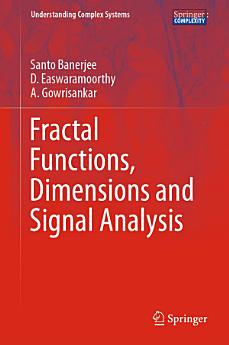Fractal Functions, Dimensions and Signal Analysis
Dec 2020 · Springer Nature
Ebook
132
Pages
reportRatings and reviews aren’t verified Learn More
About this ebook
This book introduces the fractal interpolation functions (FIFs) in approximation theory to the readers and the concerned researchers in advanced level. FIFs can be used to precisely reconstruct the naturally occurring functions when compared with the classical interpolants.
The book focuses on the construction of fractals in metric space through various iterated function systems. It begins by providing the Mathematical background behind the fractal interpolation functions with its graphical representations and then introduces the fractional integral and fractional derivative on fractal functions in various scenarios. Further, the existence of the fractal interpolation function with the countable iterated function system is demonstrated by taking suitable monotone and bounded sequences. It also covers the dimension of fractal functions and investigates the relationship between the fractal dimension and the fractional order of fractal interpolation functions. Moreover, this book explores the idea of fractal interpolation in the reconstruction scheme of illustrative waveforms and discusses the problems of identification of the characterizing parameters.
In the application section, this research compendium addresses the signal processing and its Mathematical methodologies. A wavelet-based denoising method for the recovery of electroencephalogram (EEG) signals contaminated by nonstationary noises is presented, and the author investigates the recognition of healthy, epileptic EEG and cardiac ECG signals using multifractal measures.
This book is intended for professionals in the field of Mathematics, Physics and Computer Science, helping them broaden their understanding of fractal functions and dimensions, while also providing the illustrative experimental applications for researchers in biomedicine and neuroscience.
The book focuses on the construction of fractals in metric space through various iterated function systems. It begins by providing the Mathematical background behind the fractal interpolation functions with its graphical representations and then introduces the fractional integral and fractional derivative on fractal functions in various scenarios. Further, the existence of the fractal interpolation function with the countable iterated function system is demonstrated by taking suitable monotone and bounded sequences. It also covers the dimension of fractal functions and investigates the relationship between the fractal dimension and the fractional order of fractal interpolation functions. Moreover, this book explores the idea of fractal interpolation in the reconstruction scheme of illustrative waveforms and discusses the problems of identification of the characterizing parameters.
In the application section, this research compendium addresses the signal processing and its Mathematical methodologies. A wavelet-based denoising method for the recovery of electroencephalogram (EEG) signals contaminated by nonstationary noises is presented, and the author investigates the recognition of healthy, epileptic EEG and cardiac ECG signals using multifractal measures.
This book is intended for professionals in the field of Mathematics, Physics and Computer Science, helping them broaden their understanding of fractal functions and dimensions, while also providing the illustrative experimental applications for researchers in biomedicine and neuroscience.
About the author
Santo Banerjee was working as Associate Professor, in the Institute for Mathematical Research (INSPEM), University Putra Malaysia, Malaysia till 2020, and also a founder member of the Malaysia-Italy Centre of Excellence in Mathematical Science, UPM, Malaysia. He is now associated with the Department of Mathematics, Politecnico di Torino, Italy. His research is mainly concerned with Nonlinear Dynamics, Chaos, Complexity and Secure Communication. He is a Managing Editor of EPJ Plus (Springer)
D. Easwaramoorthy received the M.Sc. Degree in Mathematics from the Bharathidasan University, Tiruchirappalli, India in 2008 and the Ph.D. Degree in Mathematics from The Gandhigram Rural Institute (Deemed to be University), Gandhigram, Dindigul, India in 2013. Currently, he is an Assistant Professor (Senior) in the Department of Mathematics, School of Advanced Sciences, Vellore Institute of Technology (Deemed to be University), Vellore, Tamil Nadu, India. His research interests include Fractal Analysis, Fuzzy Metric Spaces, Fuzzy Mathematics, Signal & Image Analysis; and Biomedical Signal Analysis.A. Gowrisankar received the M.Sc. and Ph.D. Degrees in Mathematics from the The Gandhigram Rural Institute (Deemed to be University), Gandhigram, Dindigul, India in 2012 and 2017 respectively. He got institute postdoctoral fellowship from Indian Institute of Technology Guwahati (IITG), Guwahati, Assam, India in 2017. At present, he is an Assistant Professor in the Department of Mathematics, School of Advanced Sciences, Vellore Institute of Technology (Deemed to be University), Vellore, Tamil Nadu, India. His broad area of research includes Fractal Analysis, Image Processing, Fractional Calculus and Fractal Functions.
Rate this ebook
Tell us what you think.
Reading information
Smartphones and tablets
Install the Google Play Books app for Android and iPad/iPhone. It syncs automatically with your account and allows you to read online or offline wherever you are.
Laptops and computers
You can listen to audiobooks purchased on Google Play using your computer's web browser.
eReaders and other devices
To read on e-ink devices like Kobo eReaders, you'll need to download a file and transfer it to your device. Follow the detailed Help Center instructions to transfer the files to supported eReaders.






